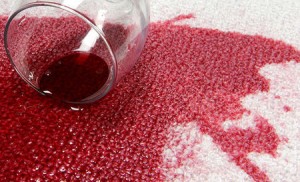The Art of Cleaning Stains – Part 1
 I have always admired how the most difficult and unpleasant things to do have been transformed into art. “The art of war”, “Martial arts”, etc. Well, it only seems fair that cleaning stains, which falls in the category of unpleasant things to do, should be considered an art form. It combines physical techniques – you cannot just wipe a stain off – some stains require wiping from the outside towards the center, while other have to be soaked into detergent first and so on. It also requires certain knowledge – it’s is, after all, chemistry. You use acids and solvents to defeat the stains. Just like martial arts, you have to react quickly and decisively, especially to a red wine stain. And with this being said, I want to declare myself your cleaning sensei and give you guidance in the art of stain removal.
I have always admired how the most difficult and unpleasant things to do have been transformed into art. “The art of war”, “Martial arts”, etc. Well, it only seems fair that cleaning stains, which falls in the category of unpleasant things to do, should be considered an art form. It combines physical techniques – you cannot just wipe a stain off – some stains require wiping from the outside towards the center, while other have to be soaked into detergent first and so on. It also requires certain knowledge – it’s is, after all, chemistry. You use acids and solvents to defeat the stains. Just like martial arts, you have to react quickly and decisively, especially to a red wine stain. And with this being said, I want to declare myself your cleaning sensei and give you guidance in the art of stain removal.
1. Cleaning dye stains on wool fabrics. When cleaning those, start by rubbing the stains with detergent or with soap. Soak the fabric in boiling water for a couple of seconds. If necessary, rub the stains with detergent again and dip them in the boiling water. Repeat until the stains are completely gone. In order to remove the soap from the fabric, soak it in the hot water. Then, wrap the wet part in a cotton towel to dry it. The rest of the spills of the dye can be cleaned with a wet sponge and dried with hot air (e.g. with the hairdryer).
2. Cleaning dye stains on white cotton fabrics. Take a glazed pot and pour 32 ounces of water in it. Add a little bit of baking soda and grinded soap or detergent to the water. Heat the mixture until the soap dissolves completely. Squash the stained area and soak it several times in the boiling liquid for a few seconds until the stain is cleaned. If this procedure leaves marks from the dye, soak the cloth in hot water and bleach it.
3. Cleaning nitrocellulose glue stains. Cleaning stains from any fabric, except silk, can be done using amyl acetate. Put the stained area of the fabric over a cleaning pad and use the amyl acetate to rub it off. The treated area is then cleaned with a tampon, soaked in gasoline. The lining of the stain can be cleaned with a sponge and, after drying the fabric with a clean towel, sprinkle chalk over it. Nitrocellulose glues form hard stains with a glazed surface which are strongly attached to the fabric.
4. Cleaning rubber glues stains. These glues form a sticky stain which attaches to the surface of most fabrics. They can be cleaned using a tampon, soaked in gasoline. When done, sprinkle chalk over the wet area.
